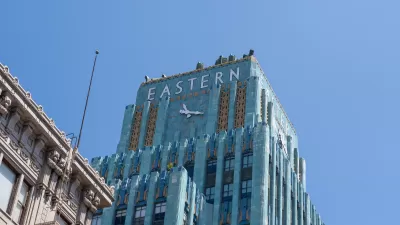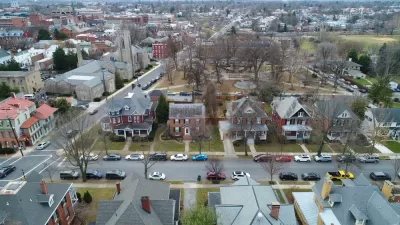The decision to protect a non-historic parking lot as part of designating an adjacent historic bank building is being derided by critics as another form of exclusionary zoning.

The inclusion of a parking lot in a historic landmark designation by the District of Columbia’s Historic Preservation Review Board (HPRB) is raising eyebrows, writes Nick Sementelli in Greater Greater Washington, causing concern among housing advocates who say the decision will limit any future development on the lot.
The historic building at the heart of the matter is the Chevy Chase Savings Bank on Connecticut Avenue. “The landmarking of the building follows HPRB’s established norms, but the inclusion of a parking lot adjacent to the site seems to violate the board’s own precedent and national historic guidance.”
Although “Using the historic nomination process like this to control future land use is supposed to be impermissible,” the HPRB acted on the claim from Historic Chevy Chase and the DC Preservation League (DCPL) that preserving the lot is important “to prevent too tall a building from being built on the lot in the future” and “ruin” the bank building’s ambiance.
According to DCPL Executive Director Rebecca Miller, “the bank and the parking lot share a single tax lot, and that DCPL uses tax-lot boundaries when drafting nominations.” The preservation groups say they are “not trying to prevent all development on the parking lot,” but having to go through historic design review in the future will likely ensure that any future building will be limited in size.
For Sementelli, “Preemptively limiting the scale of infill development on a parking lot by surreptitiously sliding it into a landmark application for a specific building” looks suspiciously like exclusionary zoning that “is supposed to be legally out of bounds.”
FULL STORY: DC’s historic board voted to protect a non-historic parking lot. Why?

Planetizen Federal Action Tracker
A weekly monitor of how Trump’s orders and actions are impacting planners and planning in America.

Restaurant Patios Were a Pandemic Win — Why Were They so Hard to Keep?
Social distancing requirements and changes in travel patterns prompted cities to pilot new uses for street and sidewalk space. Then it got complicated.

Maui's Vacation Rental Debate Turns Ugly
Verbal attacks, misinformation campaigns and fistfights plague a high-stakes debate to convert thousands of vacation rentals into long-term housing.

In California Battle of Housing vs. Environment, Housing Just Won
A new state law significantly limits the power of CEQA, an environmental review law that served as a powerful tool for blocking new development.

Boulder Eliminates Parking Minimums Citywide
Officials estimate the cost of building a single underground parking space at up to $100,000.

Orange County, Florida Adopts Largest US “Sprawl Repair” Code
The ‘Orange Code’ seeks to rectify decades of sprawl-inducing, car-oriented development.
Urban Design for Planners 1: Software Tools
This six-course series explores essential urban design concepts using open source software and equips planners with the tools they need to participate fully in the urban design process.
Planning for Universal Design
Learn the tools for implementing Universal Design in planning regulations.
Heyer Gruel & Associates PA
JM Goldson LLC
Custer County Colorado
City of Camden Redevelopment Agency
City of Astoria
Transportation Research & Education Center (TREC) at Portland State University
Jefferson Parish Government
Camden Redevelopment Agency
City of Claremont





























